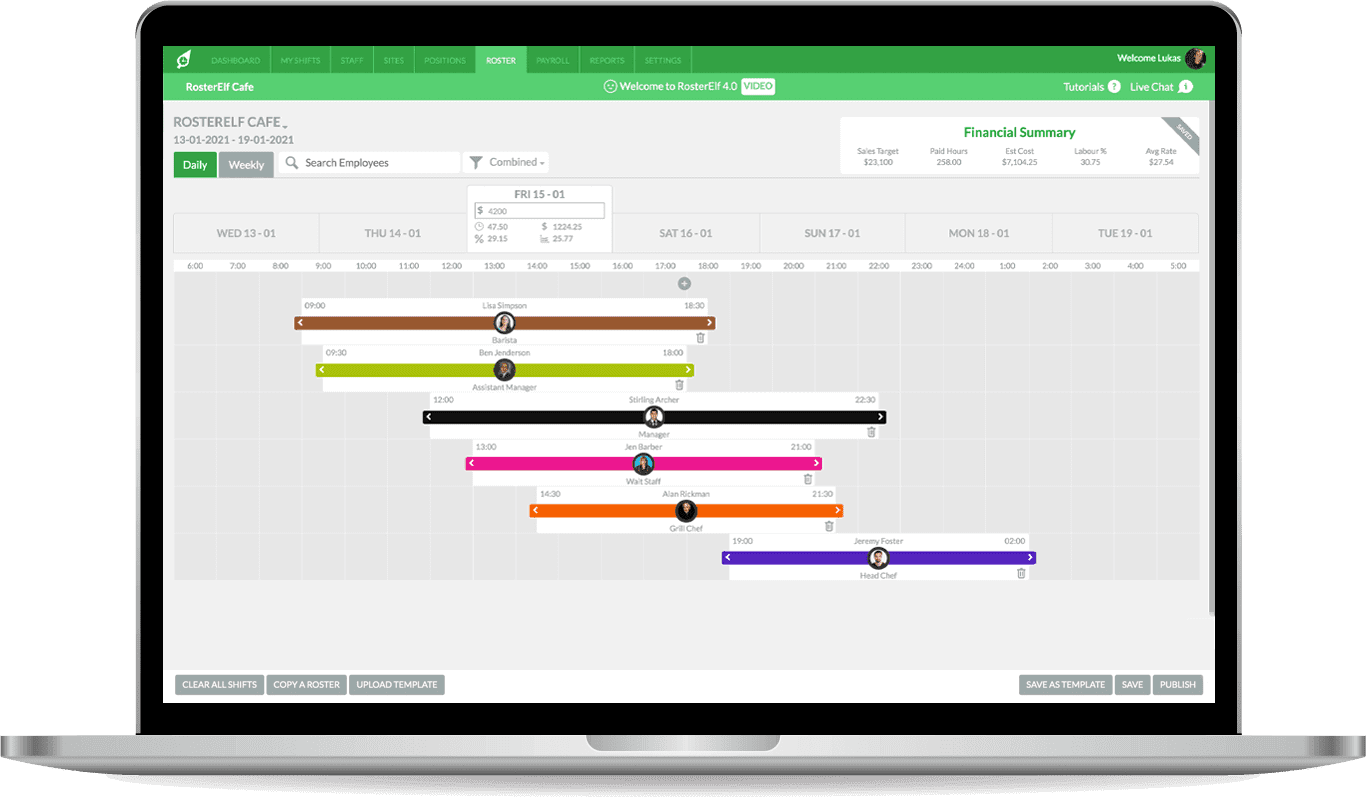What Are Shift Patterns? A Guide Work to Schedules
Understanding and effectively managing shift patterns is crucial in today's diverse and dynamic work environments. This comprehensive guide delves into the intricacies of shift patterns, offering insights into maximizing workforce efficiency and employee well-being. What time do I start? What time do I finish? How many hours am I working? These are typical questions most employees have when starting a new shift pattern.
Ensuring your workforce has sufficient employees is the shift pattern's primary goal. This can either be in the form of person-hours or coverage perspective. For example, a factory may need more human resources during a significant order season, whereas a brick-and-mortar shop will need enough workers daily. This guide also addresses key aspects of workforce management, rostering, and scheduling, essential components in developing effective shift patterns.
As you read along, you’ll better understand shift patterns and how they can maximize workforce management and productivity.
What is a Shift Pattern?
A shift pattern is simply a schedule that dictates when an employee is required to work. Shift patterns can vary widely, but they often involve working different hours on different days of the week. For example, a standard shift pattern for retail jobs is working weekends and evenings during the week. This shift pattern is known as a "weekend warrior" schedule.
There are many other types of shift patterns, including:
-
Early bird (starting work early in the morning)
-
Night owl (working late in the night)
-
Graveyard shift (working overnight)
-
Split shift (working two shifts with a break in between)
-
On-call (being available to work at any time)
-
Rotating shift (working different hours each week)
In addition to the commonly known patterns such as Early Bird and Night Owl, let's explore some advanced and tailored shift patterns, much like those discussed in our industry counterparts' articles. These include the '4 on-4 off' system, the flexibility of the 'Split Shift' model, and the structured 'Rotating Shift' patterns, each catering to different organizational and employee needs.
Each type of shift pattern has its pros and cons. For example, the early bird pattern may be better for people who want to avoid traffic or prefer to finish their workday early. Night owl shift patterns may be better for people who are more productive at night or enjoy the nightlife.
Ultimately, it is up to every employee to decide what type of shift schedule is best suitable for them. There is no one-size-fits-all answer when it comes to choosing a work schedule. What seems doable for one person may not be workable for another.
Experimenting with various shift arrangements is one of the strategic ways to figure out different work schedules suitable for your employees' needs. Moreover, a shift pattern can offer much flexibility and be a great way to manage an employee’s time. With some planning, your team can eventually find a shift arrangement that works for them.

Early Bird Shift Pattern
An early-bird shift is a work schedule that starts earlier than the traditional workday. This shift is often used in industries where employees must be on the job before customers or clients arrive. For example, many retail stores open their doors at least an hour before opening time to allow employees to stock shelves and prepare for the day.
Night Owl Shift Pattern
A night owl shift pattern is a shift that starts later in the day and extends into the evening or even the early hours of the morning. Night owl shift patterns are often used in industries where employees must be available after regular business hours, such as customer service or security.
Graveyard Shift Pattern
A graveyard shift usually starts in the evening or night and extends into the wee hours of the morning. If your industry requires employees to be available after regular business hours (e.g. security or customer service), you may want to consider implementing a graveyard shift pattern.
Working night shifts can have advantages, such as having ample time to spend with family or friends or sleeping during the day when it is hot outside. However, like other shift patterns, this one has its downsides, too, such as feeling tired during the day and having difficulty sleeping at night.
If you work a night shift, there are some things you can do to help you stay awake and alert, such as drinking coffee, eating healthy snacks, and getting some exercise.
Split Shift Pattern
A split shift scheduling is a work schedule where an employee works for two or more hours, takes a break for several hours in the middle of the shift, and then returns to work for another shift.
Some advantages to working a split shift include having a more extended break in the middle of the day and being able to sleep during the night. However, there are also some disadvantages to working a split shift, such as having difficulty balancing work and home life.
If you work a split shift, there are some things you can do to help make it easier, such as scheduling your breaks through employee management software around your shift, communicating with your family and friends about your work schedule, and being adaptable to it.
On-Call Shift Pattern
An on-call shift is where you are not scheduled to work at a specific time, but you are on call in case someone calls out sick, or there is an emergency; in short, you're on standby mode. On-call shifts can be beneficial because they can give you flexibility with your schedule.
However, on-call shifts can also be stressful because you may not know when you will be working, and you may have to work at odd hours. If you work an on-call shift, there are some things you can do to help make it easier, such as having a backup plan for child care, communicating with your family and friends about your work, and being flexible with your shift.
Rotating Shift Pattern
A rotating shift pattern is a type of shift where employees work different shifts each week. For example, an employee may work the early shift one week and the late shift the following week. Rotating shift patterns can be beneficial because they give you variety in your work schedule, especially when using scheduling apps.
However, rotating shift patterns can also be challenging because you may have to adjust your weekly sleeping schedule. If you work a rotating shift pattern, there are some things you can do to help make it easier, such as maintaining a regular sleep schedule, communicating with your family and friends about your work schedule, and being flexible with your work schedule.

Real-World Applications and Case Studies of Shift Patterns
To better illustrate the impact of effective shift pattern management, let’s delve into some real-world examples. For instance, a retail company successfully implemented a 'Staggered Shift' model to manage peak holiday seasons, resulting in increased customer satisfaction and employee morale.
Retail Company Implements 'Staggered Shift' Model
A prominent retail chain faced challenges in managing customer flow and staff workload during peak holiday seasons. To address this, they implemented a 'Staggered Shift' model. Under this system, employee work hours were distributed throughout the day, ensuring constant coverage during high-traffic periods without overburdening any single shift. This approach not only enhanced customer service during busy hours but also improved employee satisfaction by offering more flexible working hours. As a result, the company saw a marked increase in customer satisfaction scores and a decrease in employee turnover rates.
Manufacturing Plant Adopts '4 On-4 Off' Shift Pattern
A manufacturing plant struggling with employee fatigue and declining productivity switched to a '4 On-4 Off' shift pattern. This pattern involved employees working four consecutive 12-hour shifts followed by four days off. The change meant employees had more time to rest and recuperate between shifts. The result was a significant improvement in overall productivity and a reduction in workplace accidents attributed to fatigue. Employee feedback also indicated a better work-life balance, leading to higher job satisfaction.
Healthcare Facility Utilizes Rotating Shifts for 24/7 Coverage
A healthcare facility providing round-the-clock patient care adopted a rotating shift pattern to ensure continuous coverage. Staff worked in rotations, alternating between day, evening, and night shifts over a period. This rotation helped distribute the burden of night shifts more evenly among staff, reducing burnout and ensuring that patient care remained consistently high quality at all hours. The facility also introduced shift swapping and self-scheduling options, allowing staff greater control over their work schedules, which improved morale and reduced absenteeism.
Tech Company Offers Flexible 'Split Shifts' for Global Team Coordination
In a tech company with a global team, coordinating across time zones was a significant challenge. The company introduced flexible 'Split Shifts,' where employees could choose to split their workday into two blocks, allowing for real-time collaboration with colleagues in different time zones. This flexibility led to more effective team communication and project management, as well as improved work-life balance for employees, who could schedule work around their personal commitments.
These case studies demonstrate how different industries can effectively implement various shift patterns to address specific operational challenges and enhance both employee well-being and business outcomes.
Which Shift Pattern Is Popular?
There are a few shift patterns that are commonly used in workplaces. The most popular shift pattern is the Monday to Friday, nine-to-five shift. This shift pattern is often used in office jobs and other professional roles. It allows you to have weekends off, which can be great for spending time with family and friends.
Another popular shift pattern is the rotating shift pattern. This shift pattern involves working different hours each day of the week. For example, you may work from eight to four in the afternoon on Monday, Tuesday and Wednesday.
Then, you may work from midday until eight in the evening on Thursday and Friday. Rotating shift patterns can be challenging to manage, but they can be beneficial if you need to be available for customer service during different times of the day.
Regardless of what shift pattern you choose, or you end up shift swapping with a colleague, you must be getting enough rest. Doing so can help you start your workday fully charged up without feeling ragged.
More so, working long hours can be tough on your overall well-being, hence emphasising taking good care of yourself. Make sure you also eat a balanced diet for a healthier mind and body.
Changing an Employee’s Shift Pattern Without Notice
It is generally not advisable to change shift patterns without prior notice. Doing so can disrupt the work-life balance of your team members and cause them to be resentful. Not to mention, this is a red flag that is against fair work compliance.
If you need to change, try giving as many updates as possible so your team can adjust accordingly. Use your employee management software to send new rosters out well in advance or reach out through communication channels.
Takeaway
Shift patterns are a way to organise work schedules so that employees can work different hours on different days. There are many different types of shift patterns, and the best one for your business will depend on your industry and the needs of your employees. If you have employees who need to work night shifts, there are some things you can do to help them stay awake and alert.
And if you’re planning to switch to a more accessible route of setting up shifts, RosterElf does the job for you. Our rostering tool can help you save time, create a business budget you can stick to, and optimise team productivity.
As we’ve seen, adeptly navigating the world of shift patterns is not just about scheduling – it's about strategically aligning workforce management with organizational goals and employee wellness. Embrace these insights to transform your approach to shift patterning and witness a significant boost in operational efficiency and employee satisfaction.
Get access to our app firsthand. Enjoy your 15-day access to our tool for free!



